Search Expertbase
Hire Albert
Virtually
Hybrid
In-Person
SUPER POPULAR!
The 'Unprofitability' Of Modern Technology
109 Claps
2610 Words
14 min
Of all the findings on business strategy yielded by the study of the businesses in the PIMS? database, the following is one of the most controversial: Businesses that are highly investment intensive, i.e., those that use high levels of investment per dollar of sales revenue (telecommunications network providers, bulk chemical companies, utilities), are much less profitable than businesses with lower levels of investment per dollar of sales.
This finding is controversial not because the phenomenon is rare, uncertain or weak - it is common, quite clear and extremely powerful - but because it is so unexpected. The conventional wisdom is that there is a strong positive relationship between investment intensity and 'modernity' or 'progressiveness'.
Everyone knows that modern technology requires elaborate machinery, and thus heavy investments, and that high labour productivity depends on extensive automation, and thus on heavy investments. Since modern technology and high labour productivity are judged to be 'good' things, they are expected to improve profitability rather than hurt it.
The basic fact
This table shows the 'unprofitability' of modern technology, in terms of ROI: Referring to exhibit 1, 'investment' includes both working capital and fixed capital (at net book value). The figures reported in this article are four year averages. With a different definition of investment (e.g. pre-depreciation book value or current replacement value) or a different performance index (e.g. profit as a percentage of value added) or a different time period (e.g. three years or five years), the specific numbers are moderately different, but the strategic message is the same. What in fact happens is that (a) the commonly expected public benefits of investment-intensive technology (higher wages, lower prices, and improved product quality) do indeed occur most of the time, but, alas, (b) the expected private benefits do not occur; instead, the profits of companies utilising an investment-intensive technology are usually rather poor.
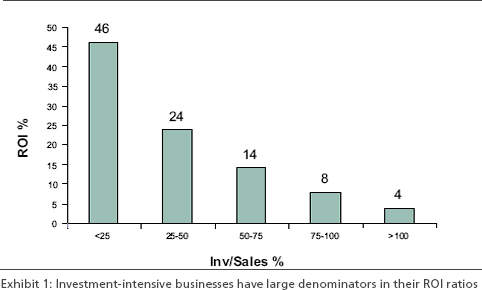
Why does investment intensity hurt profits?
Before answering that question, it is important to confirm that this is an issue that is real and substantive, not just an optical illusion. For example, it might be argued that the negative pattern in Exhibit 1 is due entirely to arithmetic: that investment- intensive businesses have large denominators in their ROI ratios, and that their returns are low for that reason alone. That possibility can be excluded by using another measure of profitability. For example, Exhibit 2 relates investment intensity to the ratio of Residual Income to Sales. 'Residual Income' equals pretax operating income less a financial charge of 10% on the investment used in the business. (Other rates of financial charge produce different slopes but the same basic pattern. Even so unrealistic an assumption as a zero cost of money produces a slightly negative slope). The similarity of the pattern to that of Exhibit 1 confirms that investment-intensive businesses are actually less profitable.
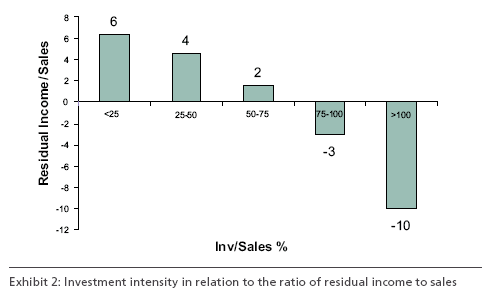
Another possible argument is that the negative effect of investment intensity is actually due to something quite different. Specifically, it is well known that businesses with high shares of their served markets are considerably more profitable than those with low shares. One of the reasons for that relationship is that high-share businesses tend to be more efficient users of investment and are therefore less investment-intensive, while low-share businesses are often inefficient users of investment and are therefore more investment-intensive. The negative effect on profit of high investment intensity might therefore be no more than the reverse side of the coin of the favourable effect on profit of high market share. To exclude that possibility it is necessary to establish that there is an effect on ROI from investment intensity in addition to that from market share. Exhibit 3 shows that there is indeed such as effect. The ROI number in each category is the four-year average for the businesses falling into that category.
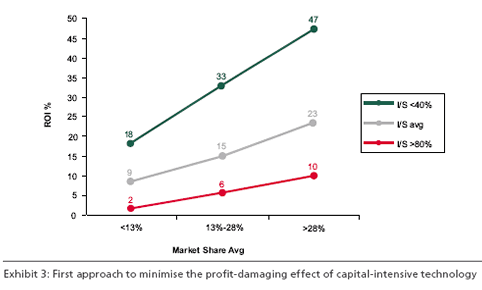
All the businesses in a given column have similar market shares, but, going down a column, investment intensity goes up. That fact that ROI decreases sharply as moving down each column confirms that investment intensity has a negative effect on profit, regardless of market share.
It has also been examined, within each of the classes of investment intensity, not only ROI itself but also the degree to which the ROI of the group of businesses is lower or higher than would be expected from their levels of market share alone. It does in fact turn out that investment-intensive businesses are even less profitable than would be expected from their market share, further confirming the phenomenon as a real and important one.
A third argument might be that low ratios of sales to investment (i.e., high levels of investment intensity) are actually due to low levels of capacity utilisation. A similar test of this hypothesis yields a similar result.
Why does it happen?
The major reason for this negative effect seems to be that the game of competition is played in a very different way in investment-intensive industries than in others. When each of the firms competing in a particular industry has committed heavy investments on which a reasonable return needs to be earned, each becomes rather eager to keep its capacity loaded. In an investment-intensive facility, volume is commonly believed to be the key to profitability. (Perhaps surprisingly, this belief is as common in industries where the investment consists largely of working capital as it is in those where the investment is largely fixed capital.) The competitive process in investment-intensive industries readily degenerates into a volume-grubbing contest, punctuated with frequent price wars, marketing wars and other over-intensive competitive measures that take most of the joy out of being modern, automated or otherwise investment-intensive. In particularly good years, when every company's capacity is almost fully loaded, this effect may not appear at all, but when good years are averaged with bad, as in the exhibits presented here, the negative effect on profit is quite clear.
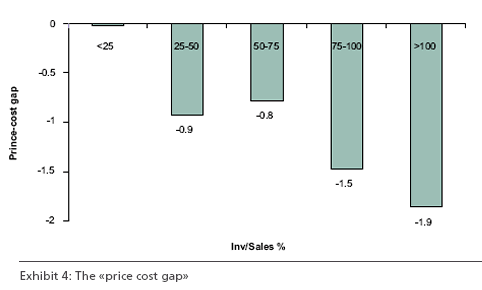
Exhibit 4 demonstrates this by plotting the 'price cost gap' (difference between % p.a. selling price growth and a weighted average of % p.a. labour rate growth and % p.a. material cost growth) as a function of investment intensity. The gap is usually negative (prices get squeezed relative to cost inflation so require offsetting productivity gains).
The squeeze is most severe for investment intensive businesses.
The profit-depressing price squeeze also shows up clearly when we examine the value added per employee in industries that differ in their investment intensity. 'Value added' is the degree to which a business upgrades the market value of the raw materials or components it buys, i.e., the difference in market value between what the business buys and what it sells.
Exhibit 5 shows that the value added per employee does not increase with added investment intensity over a surprisingly wide range.
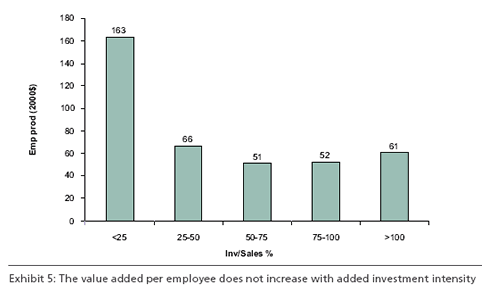
Note: The estimate of 'value added' has been adjusted for abnormally high or low earnings.
It appears that employees working with the support of large investments produce no more value than those working with only small investments. How can this be? It is possible that the first group of employees is simply less productive as individuals, that they are less capable people? More likely, however, is that the more intensive price competition occurring in investment-intensive industries reduces the market value of their product, and hence the value added by their activities.
A closely related reason for the unprofitability of investment-intensive businesses lies in their apparent inability to manage their personnel levels in a suitable fashion. The number of employees per dollar of sales is nearly as high as in less investment-intensive industries. Higher numbers of people in other functions on average counterbalance the lower numbers in manufacturing functions.
Before we leave this subject, it is worth noting that our various exhibits have undoubtedly slanted reality in favour of investment-intensive businesses, and therefore have understated the magnitude of the problem. This bias occurs because our statistics are drawn from accounting records that are kept in the conventional way. Conventional accounting procedures overstate ROI, particularly of investment-intensive businesses, both by overstating the numerator and by understating the denominator. The reason is the same in both cases: fixed assets are valued at their historical cost, rather than at their current inflated worth, understating both depreciation costs (and thus increasing apparent earnings) and investment levels.
If the technology of your business clearly requires a high level of investment intensity, either of plant and equipment or of working capital (or both), what actions should one take?
First Principle: Don't automatically assume that more is better insofar as investment intensity is concerned. A highly automated plant is not necessarily a better plant than a less automated one, no matter how wondrous it may be to behold.
Of course, the recent series of cash crunches in the economy has already cured many executives of this knee-jerk reaction, but old habits die hard, particularly in industries such as bulk chemicals, where increased capital intensification has long been a way of life.
Most of us still unquestioningly assume that good technology is almost synonymous with automated production or long and full pipelines in distribution. And that assumption is valid just often enough in particular cases to save it from being wrong. However, the proverbial 'hard look' is clearly justified with regard to all investments that are larger than proportional to an increase in capacity.
Second Principle: In evaluating a proposed investment which is clearly larger than proportional to a capacity increase, consider the strategic effect as carefully as the cost effect. A negative strategic effect may more than offset a positive effect on cost.
Suppose, for example, that you are considering a capital-intensifying project (say, an increase in the degree of automation of your plant) which, on the basis of conventional cost calculations, will have an annual operating cost, everything included, of $1,000,000, an annual saving of $3,000,000 in reduced labour costs or reduced spoilage, and therefore a net benefit of $2,000,000 per year.
Suppose further that all of these estimates are accurate, and that the net saving of $2,000,000 per year does in fact materialise as promised. Even then, the project may not be, and very frequently is not, profitable. Although, $2,000,000 would be saved, the $2,000,000 wouldn't be kept. Instead, it would be given away, mostly to customers, secondarily to employees, and thirdly in the form of higher marketing costs.
This would not be done out of choice. One would be forced to do it by changes in the competitive climate. First, the competitors' and ones own increased desperation for volume (to keep those expensive plants with their high fixed costs loaded) leads to price and other concessions to customers, particularly after the new technology has become widespread; second, ones increased fear of plant shutdown leads to higher wage settlements and a greater reluctance to discharge unneeded people; and third, one may well be caught in more and more intense marketing wars. So, frequently the net effect of the new technology is that its benefits accrue to customers and to the labour force, while one is left with the costs and the investments. It is a very good deal for others, but not such a good deal for the inventor.
Now, the message of this scenario is not, of course, that any capital-intensifying investment should automatically be rejected, but rather that its strategic effect should be estimated as carefully, before the event, as its cost effect. The net result, in many cases will clearly be against the contemplated project, no matter how glamorous it may be. However, while the project may have a negative net prospect as far as percentage return on investment is concerned, it may quite often have a favourable prospect as far as dollar results are concerned, because the lower percentage is applied to a larger percentage base. In such cases, a rather difficult management decision is required - difficult because it involves a trade off between an increase in sales and dollar profits on the one hand, and a decrease in the rate of profitability on the other.
Third Principle: Adopt a market strategy that minimises the profit-damaging effect of capital-intensive technology.
The PIMS database suggests several ways to accomplish this, many of them leading to increased earnings, if not increased ROI levels or higher profits to sales ratios. Let us briefly examine three such moves.
The first is suggested in Exhibit 3. If you look only at the bottom line, where the highly investment-intensive businesses are located, you will note a sharp increase in profitability as you move from left to right, from 2% average ROI to 10%. Even at approximately equal levels of investment-intensity, the high-share businesses do much better than the low-share businesses. This observation may seem rather obvious and unhelpful, until we remember that market share is measured relative to the served market, i.e., relative to that segment of the total potential market in which the business is operating.
For example, a smaller geographic area or a more specialised class of customers, in other words, to remain an equal size frog but in a smaller puddle. (Of course, if you can also manage to become a larger frog, so much the better, as long as the price of doing so is not too high.) Since market-segmentation efforts can often move a business toward the right on Exhibit 3, market segmentation or redefinition is clearly one strategic answer to the profit-depressing effects of capital intensity. The recent histories of some segments of the specialty steel and pharmaceutical industries illustrate this principle.
So, one way in which a business can obtain high market share is to concentrate its efforts on a segment of the total potential market.
A second approach is implied in Exhibit 6. Here we are dividing businesses according to their investment intensity and breadth of their product line relative to their competitors.
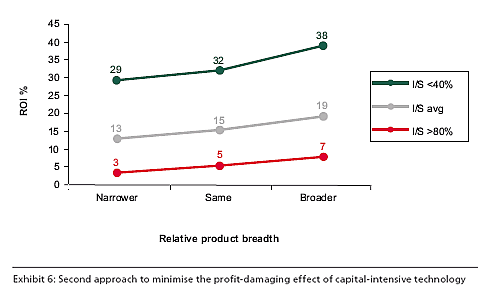
When we focus on investment-intensive businesses in the bottom row, one can see that a product line that is broader than competitors' is clearly prefer-able to one that is not. This observation can be combined with the previous one. An investment- intensive business can be quite profitable if it focuses on a relatively narrow and 'conquerable' market segment, and covers that segment really well, with a broad and diverse line tuned to the preferences of that segment.
A third approach to profit protection in investment-intensive businesses is to be sure to obtain adequate productivity improvement for the increased investment. It has already been noted that productivity rises more rarely than one would expect, but where it does rise, it certainly helps. Exhibit 7 gives the key facts.
-----------------
Summary Observations:
Investment intensity, contrary to common expectations, has a negative impact on profits, in relation to both investment and sales.
1. The major reason lies in the competitive climate associated with high capital intensity.
2. An important secondary reason lies in the common inability of investment-intensive businesses to realise adequate savings in labour and other costs.
3. There are market strategies that make an investment-intensifying move more profitable, or minimise the damage at least in monetary terms.
One of the major uses of PIMS' models is to identify and calibrate such market strategies, both in general and insofar as they apply to specific businesses.
This Article is authored / contributed by ▸ Albert Einstein who travels from Ulm, Germany. Albert is available for Professional Training Work both Virtually and In-Person. ▸ Enquire Now.
Comments
What's your opinion?
54 more Articles by Albert
Management -The Handling Of Complexity
9 min. Complexity has been one of the most frequently used words for some years now. People talk about complex systems, complex interrelationships, complex problems ...Who Knows Whom, And Who Knows What?
13 min. Employees' personal connections can be as valuable as their individual knowledge base. Social network analysis, or SNA, helps maximize a company's collective smarts.The Top Ten Things Customers Want
3 min. Over the last two years of working with hundreds of clients from all walks of life, I have noticed trends of what my clients want and need. This top ten ...POP
Eight Business Technology Trends To Watch
19 min. Eight emerging trends are transforming many markets and businesses. Executives should learn to shape the outcome rather than just react to it.The CEO's Role In Leading Transformation
15 min. The CEO helps a transformation succeed by communicating its significance, modeling the desired changes, building a strong top team, and getting personally involved.POP
Organic SEO Or Pay-Per-Click Advertising - Which Should You Choose?
8 min. Organic search engine optimization has some distinct advantages over pay-per-click advertising. However, there are undoubtedly certain situations and scenarios ...Beyond Oil: Reappraising The Gulf States
15 min. Further reform will be essential if one of the world?s fastest-growing regions is to seize a broader role in the global economy7 Ways To Stop Selling - And To Start Building Relationships!
7 min. Sometimes we can all use a friendly reminder to keep us from backsliding into old ways of thinking about selling that lead us down the wrong path with potential clients.Dwindling Readership: Are Tabloids The Answer?
14 min. Newspapers have tried a host of measures to halt the long-term decline in their readership, but they haven't stopped consumers from turning to TV and the ...POP
TRIZ As A Lean Thinking Tool
11 min. Lean Thinking is a highly evolved method of managing an organization to improve the productivity, efficiency and quality of its products or services. The ...How Gulf Companies Can Build Global Businesses
8 min. Companies based in the GCC states are using their petrodollars to expand into global markets. But in the long run, these companies will have to develop distinctive capabilities and skills.15 Seconds On The Web: Ten Writing Tips To Improve Sales
7 min. In 15 seconds, a visitor to your site determines whether or not they are interested in your product or service. Web usability experts can provide all sorts ...POP
Enterprise Risk Management - Risk's Rewards
21 min. Are you on board with enterprise risk management? You had better be. It's the future of how businesses will be run.Finding Facilitators That Fit!
3 min. The aim of this guide is to prepare you for discussions with a bureau, and to get you thinking about all the factors that affect your Facilitator choice.Better Operational-Risk Management For Banks
15 min. Operational risks are costly, but they can be conquered when high-ranking executives join the battle.POP
Project Success And Failure
20 min. What is success, what is failure, and how can you improve your odds for success?POP
Sales Person Or Customer Advocate - Who Do You Need To Be?
10 min. To get beyond survival and to grow both profits and margins, the successful companies of the future will be forced to become true customer experts.A Good Look At Corporate Social Responsibility
31 min. There appears to be plenty of room for much greater effort and involvement by companies and organizations around the world. Here a few thoughts and pointers.POP
Corporate Transformation Without A Crisis
19 min. The art of leading deep corporate change can be learned. The trick is to help each member of the company discover a new reality...POP
What Is The Business Of Business?
15 min. By building social issues into strategy, big companies can recast the debate about their role in society.POP
The Parkland Way - Never Thought You Could Learn From A Hospital?
18 min. Looking for inspired leadership, passionate employees, unsurpassed productivity, and grateful customers? Forget the dispirited corridors of corporate ...Strategy Session: What To Look For When Hiring A Professional Speaker
4 min. How do you know if the speaker fits? How do you avoid embarrassing mismatches?Succession Planning: Often Requested, Rarely Delivered
28 min. Surprisingly, many organizations lack a proper succession plan. One reason is that they do not have an effective succession planning process. This author ...Move Over, Baby Boomers
8 min. Gen X-ers want far more collaboration with companies - both as customers and as employees. CIOs are uniquely positioned to help their enterprises meet ...POP
Defining Customer Touchpoints
5 min. Improving the customer-centricity of your organization isn't just good business, it's also good marketing.Must Work Be Fun?
5 min. Should work be fun? Must it be fun? Today, the answer to these questions is mostly yes. What else should it be? Yet however plausible this answer might ...POP
Growth And Size
4 min. "Size is no guarantee of future success." What is strategically important is strength not size. Speed is more important than physical mass and flexibility ...Best Practice And Beyond: Knowledge Strategies
12 min. Value created by knowledge is often not captured. Five accounts of knowledge strategies.Living With The Limitations Of Success
6 min. Once companies reach a certain size, setting realistic performance aspirations gets a bit trickier.Foresee The Future
8 min. Foresee the future, that's what your customers expect, that's what you need to deliver.A New Model For Marketing
4 min. The proliferation of brands and channels is forcing companies to restructure their marketing efforts significantly.New Tools For Negotiators
15 min. Five easy-to-use tools help negotiators in complex deals arrive at a negotiating position that is not only acceptable to them but also palatable to other ...Games Managers Should Play
9 min. The success of strategic investments depends largely on the subsequent moves of competitors. Uncertainty about competitive conduct can lead executives ...POP
The Hacker's Code Of Ethics!
4 min. Recently, I came across a code of ethics for hackers (yes, it really does exist) that I'd like to share with you, because I think it really hits home with ...What Procurement Areas Should Be Outsourced
4 min. Few companies have the skills to effectively manage procurement across all spending categories. Smart enterprises should examine their procure-ment strategies ...So This Is What Communication Can Do?
13 min. Everything that we do for our clients is based on the idea that improved communications will improve an organisation's performance and contribute to the ...Speakers Don't Always Have To Be Famous
6 min. Plenty are the professionals who are on the "front lines" of the industry, knowledgeable of the countless changes, and who are willing and able to speak ...Measuring Performance In Services
16 min. Services are more difficult to measure and monitor than manufacturing processes are but executives can rein in variance and boost productivity - if they implement rigorous metrics.POP
We Need Teamwork - But Is It The Only Useful Form Of Work?
6 min. Two of today's buzzwords are Team and Teamwork. Those with a particular desire to conform to the spirit of the age portray them as the polar opposite of ...Tracking The Growth Of India's Middle Class
17 min. Over the next two decades, the country's middle class will grow from about 5 percent of the population to more than 40 percent and create the world's fifth-largest consumer market.Strength Inspite Of Size
11 min. Growth is necessary, but size is no guarantee of a successful future! Nevertheless, growth is needed. Without growth there is no life. In a certain sense, ...POP
Pros & Cons Of Pay For Performance
11 min. Somewhere in Corporate America, a human resources manager is tweaking her company's employee-incentive program. Maybe she's dumping last year's customized ...POP
The War For Talent
4 min. US Recruiting, Retaining & Developing Talent Statistics & Best PractisesA Guide For The Ceo-Elect
13 min. The days, weeks, or months between taking the job and assuming power are precious. Put them to good use.Managing Your Organization By The Evidence
17 min. An organization is much more likely to improve its current performance and underlying health by using a combination of complementary practices rather than ...POP
Intrapreneurship: Leveraging Organisational Talent
9 min. The global talent war has seen organisational leaders scratching their heads to understand how they can attract and retain the very best talent that is ...The Next Generation Of In-House Software Development
17 min. How leading-edge companies are streamlining applications development.POP
Value Talk: Getting The Most Out Of Your Speaker
6 min. Valuable insights on using your speaker to maximise the success of your event109













